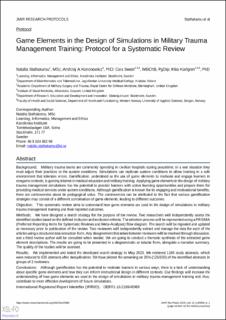| dc.contributor.author | Stathakarou, Natalia | |
| dc.contributor.author | Kononowicz, Andrzej A | |
| dc.contributor.author | Swain, Cara S. | |
| dc.contributor.author | Karlgren, Klas | |
| dc.date.accessioned | 2023-12-27T06:44:48Z | |
| dc.date.available | 2023-12-27T06:44:48Z | |
| dc.date.created | 2023-09-19T10:50:54Z | |
| dc.date.issued | 2023 | |
| dc.identifier.citation | JMIR Research Protocols. 2023, 12 (1), e45969-?. | en_US |
| dc.identifier.issn | 1929-0748 | |
| dc.identifier.uri | https://hdl.handle.net/11250/3108900 | |
| dc.description.abstract | Background:
Military trauma teams are commonly operating in civilian hospitals during peacetime; in a war situation they must adjust their practices to the austere conditions. Simulations can replicate austere conditions to allow training in a safe environment that tolerates errors. Gamification, understood as the use of game elements to motivate and engage learners in nongame contexts, is gaining interest in medical education and military training. Applying game elements in the design of military trauma management simulations has the potential to provide learners with active learning opportunities and prepare them for providing medical services under austere conditions. Although gamification is known for its engaging and motivational benefits, there are controversies about its pedagogical value. The controversies can be attributed to the fact that various gamification strategies may consist of a different combination of game elements, leading to different outcomes.
Objective:
This systematic review aims to understand how game elements are used in the design of simulations in military trauma management training and their reported outcomes.
Methods:
We have designed a search strategy for the purpose of the review. Two researchers will independently assess the identified studies based on the defined inclusion and exclusion criteria. The selection process will be represented using a PRISMA (Preferred Reporting Items for Systematic Reviews and Meta-Analyses) flow diagram. The search will be repeated and updated as necessary prior to publication of the review. Two reviewers will independently extract and manage the data for each of the articles using a structured data extraction form. Any disagreement that arises between reviewers will be resolved through discussion, and a third review author will be consulted when needed. We are going to conduct a thematic synthesis of the extracted game element descriptions. The results are going to be presented in a diagrammatic or tabular form, alongside a narrative summary. The quality of the studies will be assessed.
Results:
We implemented and tested the developed search strategy in May 2023. We retrieved 1168 study abstracts, which were reduced to 630 abstracts after deduplication. We have piloted the screening on 20% (126/630) of the identified abstracts in groups of 2 reviewers.
Conclusions:
Although gamification has the potential to motivate learners in various ways, there is a lack of understanding about specific game elements and how they can inform instructional design in different contexts. Our findings will increase the understanding of how game elements are used in the design of simulations in military trauma management training and, thus, contribute to more effective development of future simulations. | en_US |
| dc.language.iso | eng | en_US |
| dc.publisher | JMIR | en_US |
| dc.rights | Navngivelse 4.0 Internasjonal | * |
| dc.rights.uri | http://creativecommons.org/licenses/by/4.0/deed.no | * |
| dc.title | Game Elements in the Design of Simulations in Military Trauma Management Training: Protocol for a Systematic Review | en_US |
| dc.type | Peer reviewed | en_US |
| dc.type | Journal article | en_US |
| dc.description.version | publishedVersion | en_US |
| dc.rights.holder | ©Natalia Stathakarou, Andrzej A Kononowicz, Cara Swain, Klas Karlgren | en_US |
| dc.source.pagenumber | 7 | en_US |
| dc.source.volume | 12 | en_US |
| dc.source.journal | JMIR Research Protocols | en_US |
| dc.source.issue | 1 | en_US |
| dc.identifier.doi | 10.2196/45969 | |
| dc.identifier.cristin | 2176400 | |
| dc.source.articlenumber | e45969 | en_US |
| cristin.ispublished | true | |
| cristin.fulltext | original | |
| cristin.qualitycode | 1 | |

